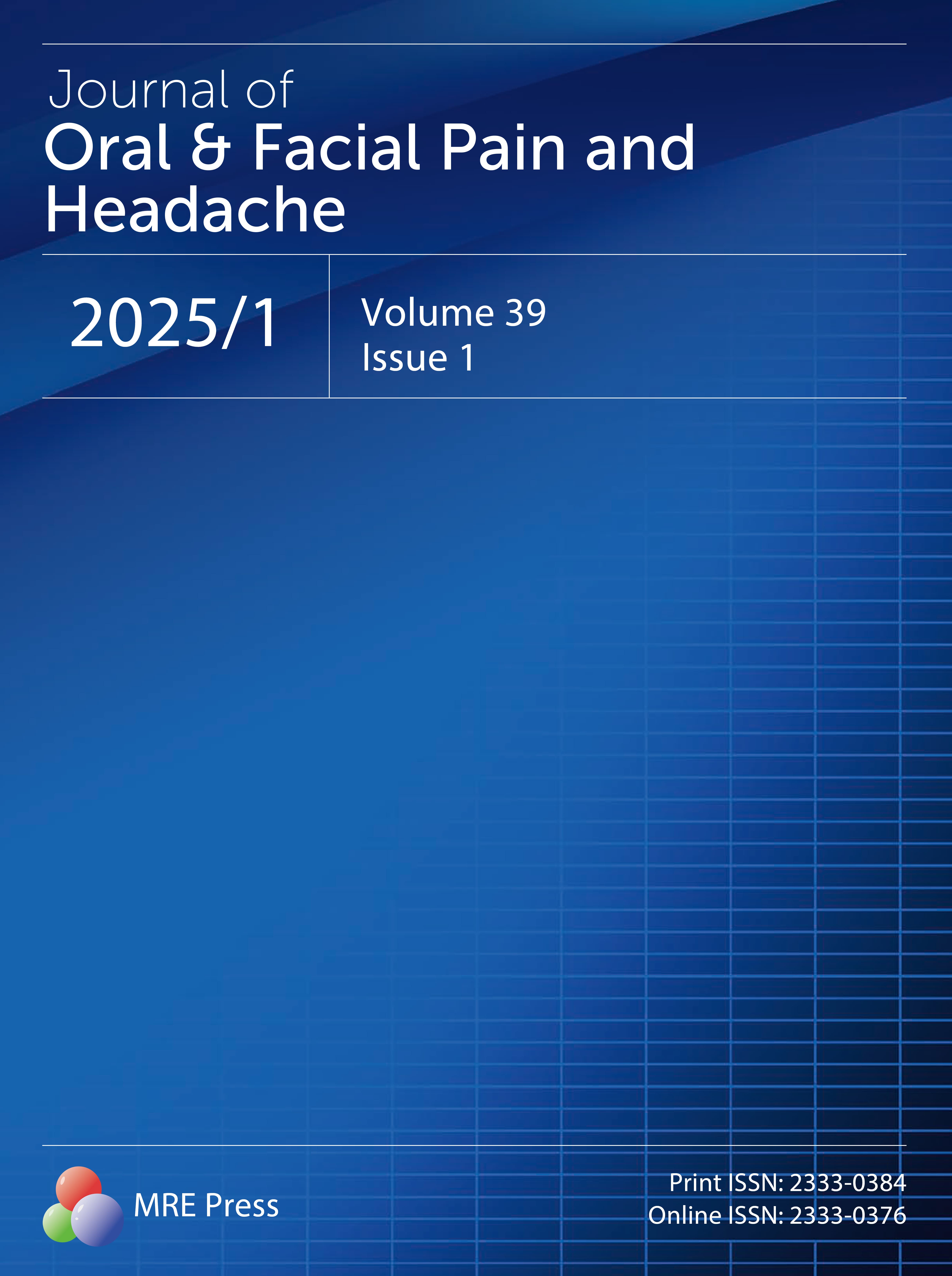Title
Author
DOI
Article Type
Special Issue
Volume
Issue
Article Menu
Export Article
More by Authors Links
Article Data
- Views 773
- Dowloads 35
Journal of Oral & Facial Pain and Headache (OFPH) is published by MRE Press from Volume 38 lssue 1 (2024). Previous articles were published by another publisher on a subscription basis, and they are hosted by MRE Press on www.jofph.com as a courtesy and upon agreement with Journal of Oral & Facial Pain and Headache.
Original Research
Open AccessPersonality Characteristics and Accompanying Symptoms in Temporomandibular Joint Dysfunction, Headache, and Facial Pain
Personality Characteristics and Accompanying Symptoms in Temporomandibular Joint Dysfunction, Headache, and Facial Pain
1Unit for Headache and Facial Pain, University of Turin, Turin, Italy
2Unit for Cancer Epidemiology, University of Turin, San Giovanni Hospital, Turin, Italy
*Corresponding Author(s): Franco Mongini E-mail: Spertino@golgi.molinette.unito.it
Abstract
Aims: Patients with different facial pain/headache pathologies usually complain of numerous accompanying symptoms relative to systemic dysfunctions or to the patient's personality characteristics. The purpose of this work was: (1) to determine the prevalence of accompanying symptoms in groups of patients with temporomandibular joint (TMJ) dysfunction and other types of facial pain or headache disorders, (2) to assess the patients' personality characteristics and anxiety levels, and (3) to see whether significant differences were found between the groups. Methods: Two hundred forty-three patients were considered. They had TMJ intracapsular disorder (TMJ, n = 71), tension-type headache (TH, n = 52), migraine (M, n = 68), chronic daily headache (CDH, n = 26), or facial pain disorder as somatoform disorder (FP, n = 26). The presence of 23 symptoms was assessed; the Minnesota Multiphasic Personality Inventory (MMPI) and the Spielberger State and Trait Anxiety Inventory (STAI) were administered and the relative scores were calculated. Four different MMPI clusters (depressive, conversive, emotional, coper) were also considered. Intergroup differences were assessed by Chi-square analysis, 1-way analysis of variance, Bonferroni t test, and a logistic regression model and then standardized for gender and age, taking the tension-type headache group as a common reference group. Results: The TMJ group had: (1) a lower prevalence of almost all symptoms; (2) significantly lower scores of several MMPI and of state anxiety; and (3) odds ratio values < 1 for all symptoms except phobias and for emotional, conversive, and depressive MMPI profiles. The FP and CDH groups had the highest prevalence of the majority of symptoms and higher MMPI and STAI scale elevations. Conclusion: It is concluded that some types of headache and facial pain seem to correlate with the presence of a number of accompanying symptoms and with some changes in personality. These changes are particularly relevant in patients with chronic daily headache and facial pain disorder. In contrast, patients with TMJ intracapsular disorders tended to show a low prevalence of accompanying symptoms and a normal personality profile.
Keywords
temporomandibular disorders; headache; facial pain; personality; anxiety
Cite and Share
Franco Mongini, Giovannino Ciccone, Francesca Ibertis, Cesare Negro. Personality Characteristics and Accompanying Symptoms in Temporomandibular Joint Dysfunction, Headache, and Facial Pain. Journal of Oral & Facial Pain and Headache. 2000. 14(1);52-58.
References

Abstracted / indexed in
Science Citation Index (SCI)
Science Citation Index Expanded (SCIE)
BIOSIS Previews
Scopus
Cumulative Index to Nursing and Allied Health Literature (CINAHL)
Submission Turnaround Time
Editorial review: 1 - 7 days
Peer review: 1 - 3 months
Publish Ahead of Print: within 2 months after being accepted
Notes: Your information is kept confidential throughout the review process.
Top
